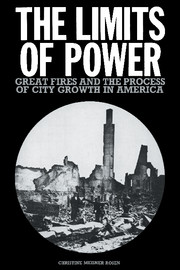Book contents
- Front Matter
- Contents
- List of figures and tables
- Acknowledgments
- Part I The conceptual framework
- 1 Introduction
- 2 The barriers to structural improvement
- 3 The barriers to infrastructural improvement
- 4 The barriers to spatial change
- Part II Three case studies
- Part III Conclusion
- Notes
- Sources of illustrations
- Index
1 - Introduction
Published online by Cambridge University Press: 22 September 2009
- Front Matter
- Contents
- List of figures and tables
- Acknowledgments
- Part I The conceptual framework
- 1 Introduction
- 2 The barriers to structural improvement
- 3 The barriers to infrastructural improvement
- 4 The barriers to spatial change
- Part II Three case studies
- Part III Conclusion
- Notes
- Sources of illustrations
- Index
Summary
On October 8, 1871, a terrible conflagration destroyed almost four square miles of densely built up land in the city of Chicago. Because the fire had been fed by tens of thousands of wooden buildings, the disaster stimulated a wave of public demand that the Board of Aldermen pass a law to prohibit the construction of frame structures in the city. The Board never actually passed the ordinance, however. Nor, ironically, did it do anything in response to demands by the Fire Department and others that it appropriate money to improve the water system, notwithstanding the fact that deficiencies in the water system, like the city's wooden buildings, had contributed to the spreading of conflagration.
Nor did Chicago's railroads respond to the demands that they take advantage of the fire's destruction to improve their rail facilities by constructing a union depot to integrate their far-flung terminals and lines, thereby reducing the costs and time-consuming inconvenience of transferring freight and passengers from one line to another. Nor did they satisfy demands that they grade their tracks to reduce the dangers and congestion of their numerous street crossings. The railroad companies built more track and terminal facilities than ever before during reconstruction. They made no major improvements in any of their existing facilities, however, again despite an obvious need and an intense public demand for such improvement.
- Type
- Chapter
- Information
- The Limits of PowerGreat Fires and the Process of City Growth in America, pp. 3 - 11Publisher: Cambridge University PressPrint publication year: 1986



